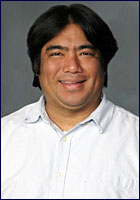Xi'an, part 2
I said I was going to write part 2 of the Xi'an trip, but the trip itself set me behind in grading, and I've been trying to get several things settled, including figuring out how to pay our tour guide (more on that later), and get everyone's visas to go to Vietnam.
And all of a sudden my internet connection goes out. I can ping the router, but not the DNS server or anything else in the area. So I'm typing this off-line and I'll upload it when the internet comes back on. The internet connection at HKBU is pretty slow, and temperamental. You'd think that in Hong Kong, where top-of-the-line technology is available for low prices, that HKBU would be much better than anywhere else I've seen, but instead it's much worse than everything else except dialup.
Anyway, the highlight of the trip to Xi'an was, for me, the trip to the Da Qin Christian monastery. See
two posts ago for a historical view of this, and see the
last post for some stuff about the stone tablet discovered in the 16th century.
The monastery was discovered many times, most recently by a team by Martin Palmer with local contact Peter Zhao (Zhao Xiaomin). In 1998 they stumbled upon this site near a famous Taoist site, and Martin, who knows Christian iconography, recognized that not only was this pagoda not a typical Chinese pagoda, but everything about it was Christian. A local nun said, "Sure, it's a Christian pagoda. We all know that."
I tried to find how to get into this site, and eventually ended up emailing Martin Palmer, who put me in touch with Peter Zhao. He arranged everything in this Xi'an trip and gave us an introduction to the Christian pagoda.
It's about an hour to the southwest of Xi'an, at the base of the Qingling mountains dividing North China from South China, in the middle of farm country. Corn fields, everywhere. People picking corn, drying corn, laying corn on the sides of roads, grinding corn. Made the folks from Ohio University feel right at home.
There are a bunch of locals trying to get us to ride horses. A few of us took them up on the offer. It's not too far to walk, and the horses don't get you there any faster, but for some, it was an opportunity not to be missed. Here's Blair Warner on one.

The pagoda stands, or rather tilts, in the middle of these corn fields. It has leaned since an earthquake in the 1500s.
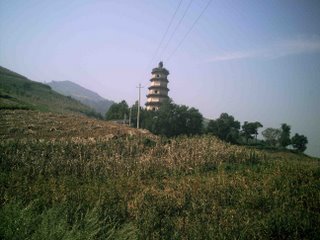
This is where there is a replica of the stone monument and where I bought the rubbings. By the way, I found out that typing in Chinese is already built into my computer. Yay, Apple! I just go to System Preferences, International, and Input Menu, and select that i want to be able to enter stuff in Chinese. 中文。That means "Chinese". It's hard to type this, because I don't have the characters marked on my keyboard, which means I'm doing this by trial and error, mostly.
So anyway, one of these days I'm going to type in the text of the rubbing and then the internet will truly have everything.
The bottom is now a Buddhist shrine, but the statues in there kind of creeped me out. I think because they're designed to appear like they're always staring at you.
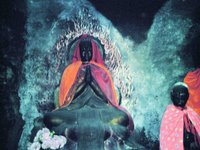
To enter the rest of the pagoda, they built a ladder out of pipes. I kid you not--there's no regular entrance; every time someone wants to come, they build the ladder again. The rungs were far apart and not consistently spaced, and it went up the side of a tilting building. Still, many of us went up.
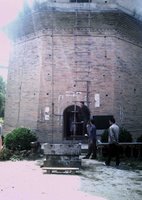
Here's a nativity scene on the second floor, or at least the direction of the legs fits the pattern of Eastern Orthodox nativity scenes.

I'd read that the stairs in 1998 were missing several pieces and the remaining pieces were in bad shape. Now they're fine, except that they are a bit irregular and sometimes slope in unpredictable ways. That and sometimes it's hard to maneuver to them. Yet there's electric lighting up here, apparently.

At the top, we rest for pictures of the scenery around us. Way down there are the horses. We truly are in the middle of nowhere.
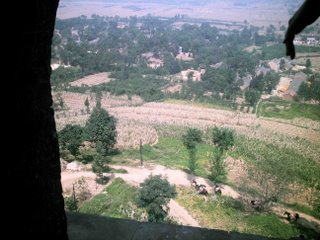
The hand there is Andrea's. She insisted on walking on the
outside of the pagoda, on the rim. In fact, dancing. Did I tell you this pagoda leans? And it's 1300 years old?! Someone else joined her. Was it Nicole? Or Delia? I forgot. But they're the ones who also joined me in
jumping off of Macau Tower. I think walking around like that was the highlight for them. For others, it was the fact that we're looking at an ancient site and we're the only tourists in sight. For me, it was the fact that this was built by people who share my faith in Jesus but who have a completely different cultural mindset, more Eastern than Western.
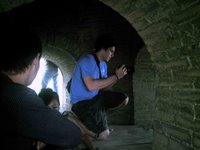
There's a sublime mixture of darkness and light here, like twilight. Very dark in the pagoda, but light coming from the outside. Here's Yee, from Ohio University, right at the border.

Then there's going back down that ladder. Yikes.
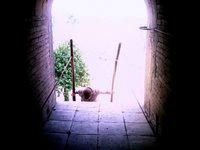
Next we went to the nearby site of Lou Tai Guan, where legend has it that Lao Zi, the founder of Taoism, wrote the "scripture" of Taoism, the
Tao Te Ching, in one night, as he was about to leave China forever to wander the mountains of the west. In the Tang dynasty, the emperors viewed themselves as descendants of Lao Zi, and emphasized Taoist sites like this one.
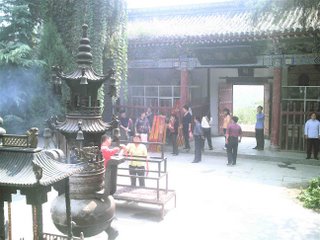
The Tao Te Ching is inscribed in tablets behind the two red-fenced areas near the entrance in the picture.
The fact that the Tang emperor invited the Nestorian church to build a pagoda in the midst of this the most sacred of Taoist complexes, so near the capital, is nothing short of astounding, especially since the emperor viewed himself as in some way a successor of Lao Zi. Perhaps there is truth in the statements of the monument that the emperor came to see truth in the Christian monks' teachings, and accepted Christianity as part of Taoism.
Still, at the side of the Taoist temple, there are a pair of bronze lions, which Peter Zhao says was built shortly after the Christians put up their pagoda. They are guards, and directly face the Christian pagoda. The Taoist priests may not have been able to countermand the Emperor's orders to allow the Christian pagoda, but they could set up things like this to register their protest.
The bus driver, meanwhile, bought a puppy for 100 RMB (about $12 USD) from a local farmer. He was very cute and was brown with black tiger-like stripes.
We then saw a modern Christian church in a nearby village. It was destroyed in the Cultural Revolution of the 1960s but rebulit soon thereafter.
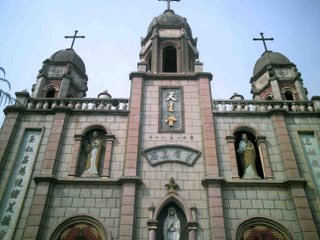
They say the Nestorian church died out long ago, but why is Christianity so strong in this countryside area? Perhaps when waves of persecution hit, they went underground every time, and according to the official documents, Christianity died out. But in reality, who can track what goes on in the remote countryside?
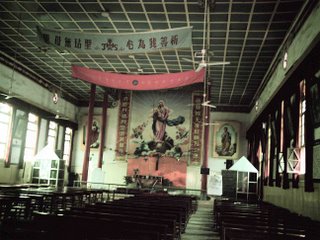
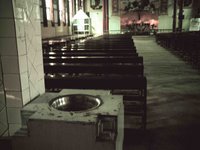
All in all, a very worthwhile trip. It was a hassle to get here, but I'm glad we came. I learned a lot along the way. And got to meet Peter Zhao. Apparently very few people come to this site--mostly the few scholars who really know about Nestorian Christianity in 7th century China. He estimates around 500 people came to visit last year. More than I thought, but still really very few.
I'm really indebted to Peter. Now, fairly literally. I brought HK$10,000 to help pay for things when I arrived but I didn't have the full amount. The reason for that is my bank has a limit for how much I can withdraw in one day. The students are paying me back now, but in US dollars in checks, which I will mail to my bank. Peter said we should go to the bank to do a cash transfer. I hand them my credit card, and they deposit the money into Peter's account. This did not work. One bank said we had to go to the main branch to do transfers. We went to the main bank and they couldn't get my card to work. I tried several cards, and smaller amounts. To no avail. They concluded they just can't handle international credit cards. We needed to get a card from China Construction Bank or China Agricultural Bank or something like that. You know, the regular ones you can get if you are Chinese.

This China Construction Bank in Xi'an is under construction. The bottom left stuff is bamboo scaffolding holding up tarps.
I instead withdrew the maximum from an ATM and handed it to Peter. I now have to pay the remaining balance, and it's been difficult. Peter says I can just go to a Hong Kong bank and try the same thing. Each one says I need an account there. I might get an account just to get this thing going, even though it takes a lot of random paperwork and evidence to get an account. But there's also the issue of how to get money to my new Hong Kong account from my US account. Apparently I need to tell my US bank to do it. Which then raises the question: Why not just ask my US bank to pay Peter directly?
Well, I called Washington Mutual, long distance, and they said I had to be present at the bank to do a cash transfer.
In the meantime I'm just withdrawing the maximum from my ATM so that if worse came to worse, I can just deposit the money into Peter's account.
Well, now the internet is working so I can finally upload this all. I'm still in my office at 12:34 am, because I don't want to do this at home--the internet connection there is usually so slow, it times out when I try to upload pictures onto the blog.
Adventures on Mainland China
This was an eventful weekend. We went to Xi'an. See the previous post as to why.
The first group was on the 8:30 am flight from Shenzhen to Xi'an. I now know why paying by international credit card is called "cash". They use the international credit card to reserve the ticket, but you still have to pay in cash. We didn't have that much cash on us. So I handed them a credit card. They said they couldn't handle it. Then Priscilla (a native Chinese speaker) argued with them, and then they said they couldn't handle credit cards here. We'd have to go somewhere else. Now we'd been all over both terminals by now, so we weren't happy about that. It transpires that "somewhere else" is the booth right next to the booth where we were. They explain that they'll have to charge a 4% fee. According to VISA, they're not supposed to do that. But, hey, whatever. Then they see it's an international credit card and say they have to charge a 5% fee. Again, we're willing. They then say it will take quite a lot of time to do each of ours, and we might miss our flight. So could they do them all together? I say, sure. Put it on my card. I'll collect the money later.
The second group was scheduled to leave at 4:10 pm that day. Priscilla managed to explain to them what they needed to do, so they were saved that hassle. But the hassle they received was more than enough to compensate. The ticketing agent only found one. Luckily they had Yee (an exchange student from Ohio University who speaks Cantonese) and she convinced them to let her look through the pile of tickets. She found another. But they couldn't find the last one. After arguing with them, the plane leaves without them. She tries to get them to waive the cancellation fee but they insist it's not their fault. Eventually they agree to waive the fee but the next time she tries to book through them, she will get the fee. Apparently they really didn't like her business. She tries to get them to book them a hotel room where they can stay, but to no avail. They wander around the airport and hole up on a bench. The security guard chases them off. They eventually get a hotel room, and come the next morning.
Mishaps aside, we had a great time. Since this was centered on the Da Qin Christian site, we had a somewhat different itinerary than most tourists. We first started at the Forest of the Stone Tablets museum, where the stone tablet dug up in the 16th century from around the Da Qin site is kept.

We're walking into the museum. It's easy to get ahead of a group of 10. Groups of 10 move quite a bit more slowly than smaller groups. In the front, on the left, is Sean, a student from Ohio University that's been hanging around the Pepperdine group pretty often, and has become our collective friend. Then is Blair, taking a picture, and Bonnie, and on the right, in the shadows, is Priscilla, talking on the phone. She's probably trying to explain airport check-in procedure to the group leaving on the second flight, so it's not that bad. Behind them is Delia, Nicole, Andrea, and Jenna. Mike Simon is taking pictures all over the place, so he's not in the picture.
The museum has many large stone monuments, often inscribed with famous philosophical treatises or poems. At the front is a large one done in the Tang dynasty, diligently and masterfully engraving a Confucian treatise on filial piety:

There were many impressive works here. The main reason for me, though was the Nestorian Christian tablet from the 700s AD that was unearthed in the 16th century.

Okay, that was a really bad picture. But none of the other pictures I took worked out any better. The lighting was bad, there was glass in front of the tablet, my camera doesn't have a lot of adjustments I can do, and I'm not much of a photographer. And furthermore, my camera was really low on batteries, and so some of the pictures I thought I took didn't come out. And flash was not really an option for many of these reasons put together, but mainly the battery issue.
I just put in batteries the week before I left on the trip. Luckily I had extra batteries I brought along just in case, and after we went to the Stone Tablet museum, I put them in, but even then, they were almost shot by the end of the weekend. I don't know what's up with that. Maybe when I carry the camera in my pocket I accidentally turn it off and on all the time. It's pretty easy to do accidentally.
As I mentioned in the previous post, this is very interesting to me, since it shows that the gospel maintained its integrity even as it was transplanted to a very different culture, with very little influence from Roman thought, and plenty of Eastern influence. But for our tour guide, rattling off the official line, this "shows that in those days, China had friendly relations with far away countries." A cute line now, politically, that China seeks to be accepted by the world community, but completely misses the point, from my perspective. Similarly, at a museum she mentions religious artifacts saying, "In those days there was a lot of political instability so people turned to religion for comfort." Again, it sounds like the party line.
Well, I did get better pictures of the Nestorian monument when we went to the Da Qin monastery--someone made a replica of the monument and set it up there.

Okay, that's slightly better, but not enough to read anything. Peter Zhao, who was present at the discovery of the Da Qin site, is on the right in the blue shirt. He showed us around the site.
At the Da Qin site, I bought a rubbing for 100 RMB (USD $13) of the whole front face. Here is the rubbing spread out on my bed when I got back home:

Note the Aramaic (in Syriac script) on the lower left. The Assyrian (so-called Nestorian church) still has their services in Aramaic and reads the Bible in Aramaic with Syriac script. The top part is hard to see, so here it is in closeup:

Note the cross at the top, and Eastern-style lotus along the bottom.
From upper right to lower left, reading downward on each column:
Da(great)-Qin (Roman/Persian empire) luminous teaching/religion flow-transmit Middle-country(China) tablet
One of my goals is to make the Chinese text of this available on the web. I've been frustrated by the fact that the only available resources I've found have had this only in translation, and so it is hard to tell how they translated God or Jesus or Messiah, for instance. First I have to learn to use Chinese word processors, assuming I can find one.
Anyway, in one of the museum rooms experts are doing rubbings:

They spread paper over the stone, and use a tool to push the paper into the carvings on the stone, then dab ink onto the paper, leaving white where the stone was carved. Several students bought some rubbings, but I decided to get a book with a description of all of the carvings. They weren't doing rubbings of the Nestorian tablet--I had to go to Da Qin to get that one.
After this we saw the city wall. This is not the city wall from the heyday of the Tang dynasty, but from about 1000 years later in the Ming dynasty, when this was no longer the capital of China, and the city was a sixth of its original size. Still, this wall is enormous. It runs 30 km around the city at the time, which is not as long as a marathon, but longer than a half-marathon.

They had battlements at regular intervals to more easily fit more archers to fire at incoming invaders. Note the modern and elegant-looking Howard Johnsons contrasting with the Ming dynasty battlement station.

Here is a view from the city wall down on the traffic below inside the city:

We crossed this street a few times. It was as scary as it looks. To quote the famous travel expert
Dave Barry describing the Arc d'Triomphe in Paris, "It is a moving monument to the many thousands of people who have died trying to get there".
Really. The word "traffic" assumes too much about the regularity of the behavior of automobiles to accurately be used in relation to the streets of Xi'an. Our bus driver, for instance, regularly does U turns in the middle of a major 4-lane road, across double yellow lines, with traffic coming at him, sometimes when some of the cars are passing by driving on the wrong side of the road, while dodging mopeds, pedestrians, pedestrians pulling farming carts, and random farm animals.
Probably the only thing keeping everyone alive is that they don't drive as fast as we do in the US. They can't, not on many of the bumpy roads. Even when the streets are well-paved, as in the picture above, they know to keep their speed down.
Except our bus. Because we took so long at all the stops, we were often late, and our tour guide kept telling our bus driver how late we were. And so we passed trucks, passed cars, passed taxis...
passed taxis! honking our multi-toned horn at pedestrians who wouldn't yield to that crazed bus with those crazy foreigners...
After the second group arrived on Saturday, we went to see the Terra Cotta warriors. The first emperor of China, Qin Shi Huang Di, unified China by an iron fist, and by sheer force unified the currency, the writing system, built the Great Wall (using the bodies of those who died in its construction as filler), and when scholars said he wasn't ruling according to Confucian ideals, had those Confucian texts burned, and the scholars with them. He also planned ahead for his burial, forcing thousands of artisans to make pottery replicas of the individual soldiers, generals, and horses in his army. About 30 years ago, a farmer, when digging a well, found some pottery, and this led to one of the most spectacular finds in Chinese archaeology of the 20th century. Now you find replicas of these soldiers at P. F. Chang's Chinese Bistro in LA.
The individual soldiers, then, were not new to me. What was new was the grand scope. There were three pits we know about. Here is a view of the first pit. To get a sense of scale, look not at the people in front but the people along the left and right sides of the "aircraft hangar", especially toward the back.

A closer look at the warriors:

The location of the well they were digging when they made this find:

Most of this is not even excavated yet.

I hear they're worried that they won't be able to preserve them all if they expose them to the elements now. Some people are skeptical but I accept their explanation at face value. It's enough work reconstructing the warriors and horses we already have, a process we see here, above the pits:

They say that the terra cotta warriors had paint on them when they were first discovered. The paint lasted thousands of years only to degrade quickly in the open air environment in the past 30 years. So they don't want to dig up any more until they know how to fix this.
It's taking a long time to write this post. So I'll post the rest of the stuff (about Da Qin) next time. In the meantime, take a look at this: apparently, on the day we were there, perhaps while we were there (for all we know), a German performance artist/exchange student
posed as one of the Terra Cotta warriors! We didn't see the arrest, but it was on that very day.






























